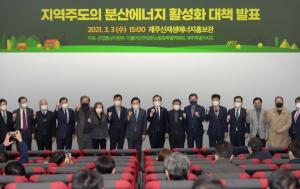Ministry of Industry announces revitalization measures including three detailed promotion tasks
Establish a mid- to long-term roadmap in the upper ring…Promote special laws in the second half
[에너지신문] While decentralized energy represented by new and renewable energy is attracting attention, the Ministry of Trade, Industry and Energy has unveiled measures to revitalize it.
On the 3rd, the Ministry of Industry announced’Regional-led measures to activate distributed energy’ at the Jeju New Renewable Energy Promotion Center.
Distributed energy is produced near the demand site and consumed in the region as small and medium-sized renewable energy, cogeneration, self-generation, ESS, and demand resources. In recent years, social demand for distributed energy produced and consumed near demand sites is increasing due to increasing social conflicts related to the construction of large-scale power plants and transmission lines.
The government has proposed a transition to a decentralized energy system through the 3rd Basic Energy Plan and the 2050 carbon neutral promotion strategy. The core content is to expand the proportion of distributed power generation such as renewable energy, collective energy, and fuel cells to 30% by 2040, expand transmission and distribution networks to cope with the volatility of renewable energy, and revitalize self-consumption.

The Ministry of Industry is planning to prepare a’roadmap to revitalize distributed energy’ through holding a distributed energy forum, conducting policy research, collecting opinions through local governments and industry briefings, and negotiating with the party government.
An official from the Ministry of Industry said, “The regional-led measures to revitalize distributed energy have taken into account the situation in Jeju Island, where a distributed energy system is essential due to the high proportion of renewable energy, and included measures that can be promoted in the short term among the contents of the distributed energy revitalization roadmap.” In the first half of the year, we will announce a roadmap for activating distributed energy, which comprehensively integrates the direction of mid- to long-term institutional improvement, such as establishing an incentive system.”
▶ What are the’three detailed initiatives’ for building regionally-led distributed energy?
In order to achieve this, the Ministry of Commerce, Industry and Energy unveiled three detailed initiatives: △realization of regional-led energy system △decentralized energy infrastructure construction △measures to minimize renewable energy output in Jeju area to achieve this goal.
First, a customized microgrid project will be promoted to supply and connect various distributed power sources in the village and to establish various energy systems reflecting regional characteristics.
For example, Woncheon Village in Hongseong-gun, Chungcheongnam-do, converts livestock manure into biogas, produces energy, and consumes it nearby. Such cases will be discovered and supported in Jeju Island as well.
In order to reinforce the energy implementation capacity of the region, we will establish a regional energy center, cooperate with the Ministry of Industry, local governments, and professional organizations, and advance the regional energy plan. In addition, regions that require systematic management of distributed resources due to the high proportion of distributed energy will be designated as special distributed energy zones to allow special cases of electricity transactions such as demonstration of the integrated power plant and distribution network operator system, and direct transactions between producers and consumers.
The Ministry of Industry is planning to first build a system stabilization ESS of 23MWh, which can accommodate additional 150MW of renewable energy, starting from Jeju Island this year to alleviate the volatility of renewable energy.
In Jeju Island, P2G technology that converts surplus power to hydrogen as a new flexible resource that will eliminate surplus power from renewable energy, P2H technology that converts to heat, and V2G technology that uses electric vehicles as ESS will be demonstrated in Jeju Island.
Along with this, Jeju Island will introduce a Plus DR system that provides incentives for consumption of surplus power from this month, and plans to solve the surplus power problem through a market mechanism.
In addition, from Jeju Island, an information provision device will be installed on renewable energy generators (100kW or more), and based on this, an integrated renewable energy control system will be built that automatically predicts and controls renewable energy.
As the increase in renewable energy in Jeju Island causes power supply that exceeds demand, measures to minimize the control of renewable energy output are also being pursued.
Jeju-Land #1, #2 HVDC sent power only to Jeju Island from land, but it plans to secure reverse transmission performance and transmit surplus power in Jeju Island to land. Through this, the renewable energy capacity in Jeju Island is expected to increase to a maximum of 342MW this year.
In addition, if the completion of the #3 HVDC capable of real-time two-way transmission according to the power supply and demand situation between Jeju and land at the end of next year, 400MW of renewable energy capacity in Jeju Island is expected to be added.
Meanwhile, the Ministry of Industry is planning to organize and operate the’Jeju Energy Council’. The Council, including the Ministry of Industry, Jeju Provincial Office, Power Exchange, KEPCO, and the Korea Energy Corporation, will participate in the inspection and implementation of follow-up measures to revitalize distributed energy led by the region.
In particular, it plans to reorganize existing energy-related laws and regulations centered on the centralized type, and enact a separate special law that will lead to the spread of distributed energy in the second half of the year.
Copyright © The Energy Newspaper Unauthorized reproduction and redistribution prohibited
